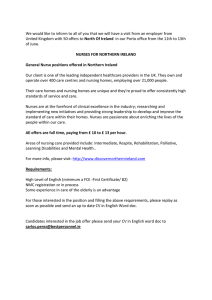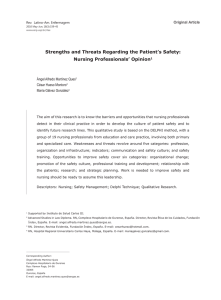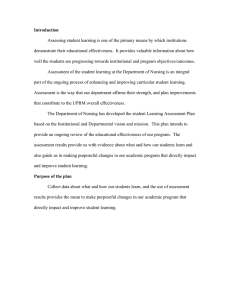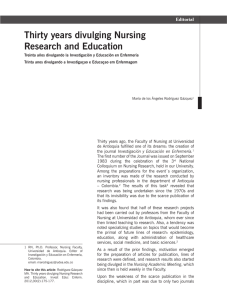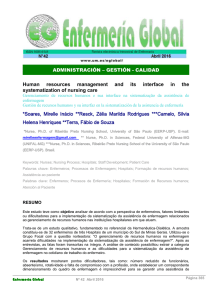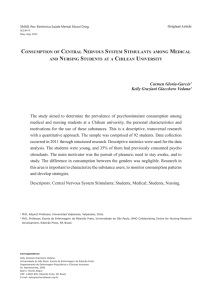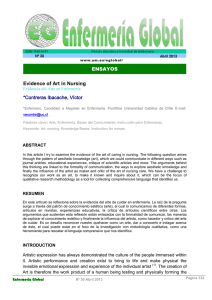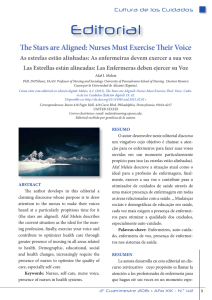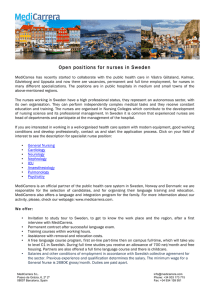quality assessment of the wound dressing procedure in
Anuncio
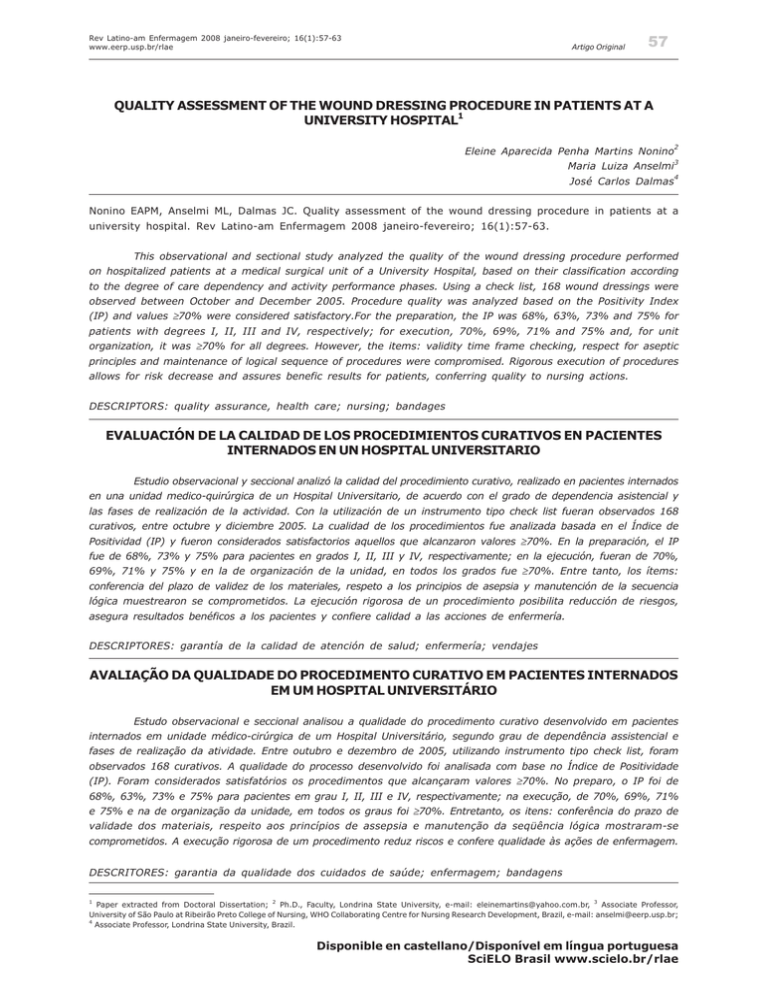
Rev Latino-am Enfermagem 2008 janeiro-fevereiro; 16(1):57-63 www.eerp.usp.br/rlae Artigo Original 57 QUALITY ASSESSMENT OF THE WOUND DRESSING PROCEDURE IN PATIENTS AT A UNIVERSITY HOSPITAL1 2 Eleine Aparecida Penha Martins Nonino Maria Luiza Anselmi3 José Carlos Dalmas4 Nonino EAPM, Anselmi ML, Dalmas JC. Quality assessment of the wound dressing procedure in patients at a university hospital. Rev Latino-am Enfermagem 2008 janeiro-fevereiro; 16(1):57-63. This observational and sectional study analyzed the quality of the wound dressing procedure performed on hospitalized patients at a medical surgical unit of a University Hospital, based on their classification according to the degree of care dependency and activity performance phases. Using a check list, 168 wound dressings were observed between October and December 2005. Procedure quality was analyzed based on the Positivity Index (IP) and values ≥70% were considered satisfactory.For the preparation, the IP was 68%, 63%, 73% and 75% for patients with degrees I, II, III and IV, respectively; for execution, 70%, 69%, 71% and 75% and, for unit organization, it was ≥70% for all degrees. However, the items: validity time frame checking, respect for aseptic principles and maintenance of logical sequence of procedures were compromised. Rigorous execution of procedures allows for risk decrease and assures benefic results for patients, conferring quality to nursing actions. DESCRIPTORS: quality assurance, health care; nursing; bandages EVALUACIÓN DE LA CALIDAD DE LOS PROCEDIMIENTOS CURATIVOS EN PACIENTES INTERNADOS EN UN HOSPITAL UNIVERSITARIO Estudio observacional y seccional analizó la calidad del procedimiento curativo, realizado en pacientes internados en una unidad medico-quirúrgica de un Hospital Universitario, de acuerdo con el grado de dependencia asistencial y las fases de realización de la actividad. Con la utilización de un instrumento tipo check list fueran observados 168 curativos, entre octubre y diciembre 2005. La cualidad de los procedimientos fue analizada basada en el Índice de Positividad (IP) y fueron considerados satisfactorios aquellos que alcanzaron valores ≥70%. En la preparación, el IP fue de 68%, 73% y 75% para pacientes en grados I, II, III y IV, respectivamente; en la ejecución, fueran de 70%, 69%, 71% y 75% y en la de organización de la unidad, en todos los grados fue ≥70%. Entre tanto, los ítems: conferencia del plazo de validez de los materiales, respeto a los principios de asepsia y manutención de la secuencia lógica muestrearon se comprometidos. La ejecución rigorosa de un procedimiento posibilita reducción de riesgos, asegura resultados benéficos a los pacientes y confiere calidad a las acciones de enfermería. DESCRIPTORES: garantía de la calidad de atención de salud; enfermería; vendajes AVALIAÇÃO DA QUALIDADE DO PROCEDIMENTO CURATIVO EM PACIENTES INTERNADOS EM UM HOSPITAL UNIVERSITÁRIO Estudo observacional e seccional analisou a qualidade do procedimento curativo desenvolvido em pacientes internados em unidade médico-cirúrgica de um Hospital Universitário, segundo grau de dependência assistencial e fases de realização da atividade. Entre outubro e dezembro de 2005, utilizando instrumento tipo check list, foram observados 168 curativos. A qualidade do processo desenvolvido foi analisada com base no Índice de Positividade (IP). Foram considerados satisfatórios os procedimentos que alcançaram valores ≥70%. No preparo, o IP foi de 68%, 63%, 73% e 75% para pacientes em grau I, II, III e IV, respectivamente; na execução, de 70%, 69%, 71% e 75% e na de organização da unidade, em todos os graus foi ≥70%. Entretanto, os itens: conferência do prazo de validade dos materiais, respeito aos princípios de assepsia e manutenção da seqüência lógica mostraram-se comprometidos. A execução rigorosa de um procedimento reduz riscos e confere qualidade às ações de enfermagem. DESCRITORES: garantia da qualidade dos cuidados de saúde; enfermagem; bandagens 1 Paper extracted from Doctoral Dissertation; 2 Ph.D., Faculty, Londrina State University, e-mail: [email protected], 3 Associate Professor, University of São Paulo at Ribeirão Preto College of Nursing, WHO Collaborating Centre for Nursing Research Development, Brazil, e-mail: [email protected]; 4 Associate Professor, Londrina State University, Brazil. Disponible en castellano/Disponível em língua portuguesa SciELO Brasil www.scielo.br/rlae Quality assessment of the wound dressing... Nonino EAPM, Anselmi ML, Dalmas JC. INTRODUCTION Companies 58 Rev Latino-am Enfermagem 2008 janeiro-fevereiro; 16(1):57-63 www.eerp.usp.br/rlae one hand, the nurses are a minority category and are attributed with the actions of teaching and start to pay attention to quality management; and, on the other side, nursing auxiliaries as from the Industrial Revolution and the theme and technicians, whose work focuses on nursing care particularly occupies a central position as from the and particularly technical procedures(7). (1) . Assuring competitiveness to the Among the actions developed by the nursing products available in the market, enlarging the profit team, the technical procedures hold risks and, in this margin and guaranteeing the economic-financial case, require continuous evaluations by the nursing survival of the organization demands standardization service, in order to assure the quality of the care and the use of evaluation instruments. process(7). early 1930’s This way, the movement towards quality, In the literature review about the evaluation primarily introduced into the industrial field and, soon of nursing techniques in the databases LILACS and after, into the field of services, expanded and gained Medline, in the period from 1996 to 2005, with (2) ground in the daily life of health institutions . In the field of quality assessment in health, descriptors extracted from Descriptors in Health Sciences: evaluation, (followed by: bandages, nursing), conceptual process evaluation (health care) (followed by: theoretical framework that is used until today in the bandages, nursing) and results evaluation (health care) evaluation processes of health services and that (followed by: bandages, nursing), few studies were involve the analysis of the following aspects: found which evaluate the quality standard of nursing Avedis Donabedian developed structure, process and result a (3) procedures’ execution through direct observation. . comprises: Among these, the assessment of nurses’, physical, human, material and financial resources nursing auxiliaries’ and technicians’ performance necessary for health care; the process corresponds through direct observation in the execution of to the set of activities developed in the relation peripheral venous puncture should be mentioned. The between professionals and users; the result refers to results indicate inadequacies in the performance the changes verified in the health condition of patients among the three categories of professionals which can be attributed to previous care and, also, investigation, supported by the Ministry of Health, changes related to knowledge and behavior and the evaluated the performance of nursing auxiliaries, The structural assessment (3-4) user’s satisfaction with the delivered care . (8) . Another technicians and attendants for inhalation, venous Recently, as from the 1990’s, the Hospital puncture for medication and intramuscular medication, Accreditation program has been implemented in Brazil. at three hospital services in Bahia. The same study It constitutes a method of external evaluation found unsatisfactory performance for all techniques performed by peers in the health field. It is developed in the three professional categories (9) . based on previously established well-known standards, A study on the execution of aseptic and septic which contemplate structure, process and result dressings in a district health center found out that (5) elements and aims to stimulate the development of 57.4% of the 101 aseptic dressings made presented “a continuing quality culture of medical-hospital care an unsatisfactory performance standard; and that (1) and health protection to the population” . The evaluation for Hospital Accreditation is 20.8% of the 206 septic dressings were executed unsatisfactorily (10) . carried out based on the Brazilian Manual of Hospital The quality of the services delivered by a Accreditation. The nursing service is contemplated in health institution greatly depends on the technical this manual, and the standards established for competence and interaction and communication ability evaluation allow for the quality verification of the of its employees towards the user, but also on other nursing care delivered to clients. aspects, such as current working conditions, material The nursing field is responsible for integral resources and support services available. direct care delivery to the patient as a biological and Among the technical procedures frequently social being, differing two specific fields of activities: performed by nursing professionals, dressings stand the care, comprehending the procedures, and nursing out, which consist in cleaning and covering the wound care administration(6). with the purpose of supporting the wound treatment In Brazil, nursing work is historically configured by its division in different categories of agents. On the or preventing colonization in the insertion locations (11) of diagnostic and therapeutic invasive devices and Rev Latino-am Enfermagem 2008 janeiro-fevereiro; 16(1):57-63 www.eerp.usp.br/rlae Quality assessment of the wound dressing... Nonino EAPM, Anselmi ML, Dalmas JC. promoting wound healing, avoiding infection and decreasing costs and damages for the patient. 59 The data collection technique was direct observation and the instrument used was a checklist, procedure elaborated based on observations of literature on the predominantly performed by nursing auxiliaries and subject(11,13-16), considering the working process of the technicians, while the nurse is responsible for nursing team, the patients’ basic human needs and supervising, providing products according to the the peculiar characteristics of the technique in the availability at the institution, guide, follow up, develop phases educative processes and evaluate the employees. organization. For the latter, it is important to make In practice, dressing is a of preparation, execution and unit Considering that, in the nursing care process, clear that, according to the established routine, the the technical dressing procedure involves risks that can employees register all dressings in patients’ files only compromise nursing care quality, this study was developed at the end of their shift, which complicated the to evaluate the quality of this procedure according to the presence of the researchers in the field until the patient’s dependence level at a medical surgery ward of a moment teaching hospital in Paraná. Expectations include the consequently, the observation of this action, which identification of satisfactory and / or unsatisfactory aspects, was excluded from the instrument. the dressing was registered and, the proposal of steps that contribute to the improvement Also, a manual was developed which follows the of professional practice and evaluation processes of health instrument, including the descriptors of each item to be care quality at the study institution. observed. Both (instrument and manual) were validated regarding the content by nine judges considered experts in the subject; four of them were nursing faculty and the METHOD other five clinical nurses. After incorporating the suggestions, the instruments were tested at a medical This is an observational and sectional study surgical unit, with the observation of 28 dressings. developed at a teaching hospital in the North of The presentation of each item is followed by Paraná, which in 2005 offered 333 active beds and three answer options: “yes” (when the item is performed 816 employees. correctly), “no” (when the item is not performed), “not The hospital ward studied was the male applicable” (when the item is not applicable to the medical surgery ward, which in 2005 had a total of 73 situation observed) and also a space for comments. active beds (about 22% of the total number of beds The direct observations were made by a nurse and 11 at the hospital), nine nurses, ten nursing technicians nursing students, who were called field researchers and and 42 nursing auxiliaries. had been selected and trained for this study. The hospital has a Department of Quality Data were collected in the period from Control in Nursing Care, which every three months October to December, 2005, at mornings, in a total monitors the working processes and nursing care period of 45 days. The researchers were available at quality and, when necessary, offers training for the the unit and, as they identified an employee who was improvement of the nursing team. going to perform a dressing, they made their The Systemization of the Nursing Care has been implanted 24 years ago and, today, the stages of history, nursing prescription and annotations are developed. observation and at the same time classified the patients at their corresponding dependence level. The study was approved by the Research The study population consisted of dressings Ethics Committee at the Federal University of Londrina performed by the nursing team in hospitalized patients, and 20 employees from the unit signed the Free and classified by their dependence level (I, II, III and IV), Informed Consent Term. (12) and who The collected data were typed and stored in an presented one single wound. These levels represent, Excel database. For analysis, the Positivity Index (PI) in an ascending way, the patient’s dependence on was used, which consists in identifying, for each item of nursing care for: walking, bathing, eating, behavior, the instrument, the kind of answer observed (affirmative, self-care, medication, pre and post-operative care and negative or not applicable). When a situation in which life maintenance. This classification supports the the patient was not exposed to the observed condition development of the nursing process, organizing and was verified, the item was disregarded in the analysis, guiding nursing work and permitting an evaluation of as its inclusion in the equation would underestimate the according to a readapted instrument the procedures performed by the professionals (12) . data obtained for the index. After applying the equation Quality assessment of the wound dressing... Nonino EAPM, Anselmi ML, Dalmas JC. Rev Latino-am Enfermagem 2008 janeiro-fevereiro; 16(1):57-63 www.eerp.usp.br/rlae 60 below, the percentage of positivity for each instrument It is observed that the dressings made in item was obtained and, next, for the set of items patients classified at levels III and IV obtained according to the dependence level of the patient in every satisfactory total positivity rates of more than 70%, phase of the procedure. while those made in patients at levels I and II ⎛ Positivity Index (PI) = ⎜ ⎜ TC ⎝ ⎞ TC ⎟ x TP ⎟⎠ presented rates below expected levels. Analyzing the different items that compose the preparation phase, there is evidence of commitment in In which: ra = affirmative answers and rn = negative the “introduction to the patient”, “heating the physiologic answers. serum” and “washing hands before starting the Based on the consulted literature (8-9), the dressing”, in which the PI was ≤ 50%. At level IV, the Positivity Index (PI) equal to or higher than 70% was explanation of the procedure to the patient was carried used as the parameter for dressing quality assessment. out in 67% of the observations, perhaps because, at this level, the patient may present a decreased level of conscience, impairing communication, although there was no record of any kind of interaction between nursing RESULTS professionals and patient. The study observed 168 dressings, performed by 20 employees: 55% nursing technicians and 45% nursing auxiliaries, with a predominance of female professionals (70%), an average of 40 years old and an average period of eight years working in the nursing area. From the 168 dressings, 57 (33.9%) were performed in patients classified at dependence level I, 65 (38.7%) at level II, 33 (19.6%) at level III and 13 (7.8%) at level IV. Thus, the dressings were predominantly observed in patients classified at levels I and II. It was decided to present the data with full values, according to the tables below. Table 1 shows the PI found in the dressing preparation phase. Table 1 - Positivity Index (%) in the “Dressing Preparation” phase, according to the dependence level of the patients at the medical surgery ward of the hospital. HU/UEL. Londrina, 2005 Dressing Preparation Does he/she introduce himself/herself to the patient? Does he/she explain the proposed procedure? Does he/she prepare the material for the dressing individually? Does he/she prepare material for more than one dressing? Does he/she heat the physiological serum? Does he/she wash hands before starting a dressing? Is there any need to position the patient for the dressing? Does he/she maintain the privacy and integrity of the patient during the procedure? Total PI Level I Level II Level III Level IV (n=57) (n=65) (n=33) (n=13) 29 29 50 - 79 74 92 67 100 100 100 100 100 100 100 100 03 02 07 0 47 33 38 45 Table 2 presents Positivity Index data in the execution stage of the dressing procedure. Table 2 - Positivity Index (%) in the “Dressing Execution” phase, according to the dependence level of the patients at the medical surgery ward of the hospital. HU/UEL. Londrina, 2005 Dressing Execution Did he/she prepare the environment properly? Did he/she open the dressing package properly? Did he/she check the expiry date of the material? Did he/she keep the position / disposition of the material properly? Did he/she keep the garbage distant from the wound or next to the nippers of the first time? Did he/she use the solution prescribed to clean the wound? Did he/she keep a logical sequence? Was the first portion of PVPI, safgel or papaina tube thrown away? Did he/she keep the asepsis principle during the dressing? Did he/she choose the cover recommended by the nurse or did he/she follow the nursing prescription? Does he/she consider the pain complaints of the patient taking conduct? Total PI Level I Level II Level III Level IV (n=57) (n=65) (n=33) (n=13) 34 31 29 63 93 70 82 85 0 17 6 0 72 77 85 77 77 80 82 83 98 97 100 27 17 67 91 84 69 85 - 61 71 52 85 100 94 100 92 91 87 80 100 70 69 71 75 100 Except for level II (69%), at the other levels, the total PI reached the recommended level of ≥ 70%. This level was reached at least seven items at the four dependence levels. In some items however, the PI is below 70%, namely: “the environment was properly prepared” (≤ 100 96 95 100 100 90 100 100 (≤ 17%); and professionals never complied with this 68 63 73 75 item at levels I and IV. 63%); “the expiry date of the material was checked” Rev Latino-am Enfermagem 2008 janeiro-fevereiro; 16(1):57-63 www.eerp.usp.br/rlae 61 Quality assessment of the wound dressing... Nonino EAPM, Anselmi ML, Dalmas JC. Another item compromised in the positivity Regarding the item “heating of the physiologic was “a logical sequence was kept”, because the serum”, this stage is considered essential in the verified PI is below 70% in the dressings of patients execution of a dressing, because it is associated to at levels I (27%), II (17%) and III (67%). Levels improved healing, preservation of biochemical and were satisfactory at level IV only. The descriptor of enzymatic cell reactions, increased circulation and this item demands the use of nippers according to oxygen tension in the wound and increased cellular the four periods of the procedure execution (13,16) . When the nippers are substituted by gloves, the logical immunity with contamination the decrease of bacterial (14,16-18) . sequence and the asepsis principle need to be A stove is available at the unit, but it is maintained, which are elements that contribute to generally turned off. It is up to the nurses, through decreased infection rates in the surgical area(16-17). managerial actions, to assure the provision and For the item “the asepsis principle was kept availability of equipment, appropriate material existing during the dressing”, in patients at levels I and III, in the institution, as well as supervision and follow-up the PI was below recommended levels, in other words, of team work in order to permit the satisfactory 61% and 52%, respectively. execution of the nursing procedures. Table 3 exposes Positivity Index data in the Another fact that stands out was the lack of unit organization phase after the end of the dressing. hand washing before and after the procedure. Although the department relies on an expressive quantity of Table 3 - Positivity Index (%) in the “Unit Organization” active beds (73) distributed in 11 wards, and few phase, according to the dependence level of patients washbasins available in the corridors, there are at the medical surgery ward of the hospital. HU/UEL. containers with alcohol gel in each infirmary, not Londrina, 2005 justifying the results obtained. It is evident that the habit of hand washing or using alcohol gel is not PI Unit Organiz ation Level I Level II Level III Level IV (n=57) (n=65) (n=33) (n=13) incorporated as an important nursing action in the prevention of risks for patients and employees. Did he/she throw the used materials away right after the end of the dressing and into the right places? 100 100 100 100 Did he/she throw the used materials away after the end of several dressings? 94 100 100 100 Did he/she wash hands or use alcohol gel after the end of each dressing? 49 39 48 58 transmission, negligence, lack of material and difficult Total 73 70 75 80 access to alcohol or alcohol gel dispensers(19-20). In The obtained total positivity rates were ≥ 70%. International studies indicate health professionals’ low adherence to this procedure in different departments. The reasons that contribute to the latter are: disbelief in the risk of pathogen Brazilian literature, studies also identify that hand washing before and after the execution of nursing Even reaching satisfactory total positivity rates in all procedures is deficient, exposing the patient to hospital levels, hand asepsis at the end of the dressing infection risks. However, the causes of this behavior execution is compromised at the four levels of are not pointed out(8-9). dependence, with PI rates varying from 39% at level This procedure item involves other behavioral II to 58% at level IV, a fact that can favor cross aspects besides the technical dimension, such as infection. changes in (20) motivation attitudes, beliefs and employee . In this matter, hand hygiene demands a more direct supervision of the nurse during the DISCUSSION procedure execution. Educational processes are needed that favor the modification of already The results obtained indicate that consolidated habits. communication was deficient, although we consider Another aspect that was compromised was that, in integral nursing care, technical and the verification of the material expiry date. In the communication dimensions are indissoluble(9). Research study hospital, the center of material distribution on the execution of nursing techniques in hospitals in makes kits that contain a package of dressings, tissue the state of Bahia also found an unsatisfactory and gloves. As the employee does not check the performance material expiry date, it is possible that (s)he ends up of nursing professionals in communication/interaction items with the patient the (9) . making the dressing with a clean but not sterile Quality assessment of the wound dressing... Nonino EAPM, Anselmi ML, Dalmas JC. Rev Latino-am Enfermagem 2008 janeiro-fevereiro; 16(1):57-63 www.eerp.usp.br/rlae technique according to recommendations for a hospital (11,16) environment , endangering the patient. 62 that rigorously obeys the technical-scientific principles and professional-user interaction, will contribute to Concerning the logical sequence of the the quality of the care offered by the institution. procedure, which showed implications, there is the The use of protocols and the development / fact that, in clean wounds, it is recommended to start implementation of training processes that enable both cleaning from the less contaminated to the more nurses and the other team members to execute this contaminated areas, in other words, from the center procedure permit the improvement of professional to the adjacent areas of the wound; and, in the performance contaminated wounds, following the same principle, quantitative and qualitative standards of health care(9). and, eventually, assure certain the dressing should start in the adjacent areas and borders and finish at the center or inside the wound. This principle helps to decrease the occurrence of CONCLUSIONS synergisms in bacteria action, which cause larger wounds in the adjacent areas, avoid the dissemination The procedure execution was satisfactory in of microorganisms in ulcerated wounds, abscess and the dressing preparation phase for patients at levels surgical dehiscence and clean areas(11,13,16). III and IV, 73% and 75% respectively; in the execution In some situations, for different reasons, phase, for patients at levels I, III and IV (70%, 71% contradicting what it is advised in literature(11,13) there and 75%). For those at level II the Positivity rate was was contamination of the nippers: due to inadequate 69%, which is very close to the established parameter; handling, leading to crossing among them; by the hands in the unit organization phase, the PI obtained at all touching the sterile field; by lifting the nippers improperly levels was ≥ 70%. at the center of the sterile field or by disrespecting the However, in some items, the positivity was field limit that was divided into sterile and not sterile below the expected, including: communication with (where the part of the nippers that we touch is placed). the patient; verification of the material expiry date; It was also verified that the gloves were not changed respect for the logical sequence of procedure from the first to the second time, when the dressing development and asepsis principles. These results execution with gloves was the chosen option. indicate that the dressing execution, at the selected Regarding the environment organization, the unit, can raise the risks of infection, compromising employees’ concern with this aspect is evidenced when the healing and recovery process of the patient’s skin they discard the materials properly, not allowing them integrity, thus demanding a longer hospital stay. Such to be dispersed in the infirmaries. This behavior can aspects address the need for better work supervision be due to the nursing supervision process, in which by the unit nurses which, when developed together the nurse detects problems related to the infirmary with other team members, will contribute to improve organization more easily, like dressing leftovers, the performance of the employees and to assure the dispersed nippers and misplaced garbage. Thus, the quality in care processes. employee is determined to perform the activities satisfactorily. According The study limitations include the absence, in the data collection instrument, of the item about the of wound cleaning method, which was not identified by Accreditation, for nursing, it is necessary among other to the Brazilian Manual the judges; as well as the procedure execution record aspects to: identify, define, standardize and document in the patient’s file, elements that can also interfere its processes; establish procedures; measure and in the quality. It is also important to mention the lack evaluate the process results (5). In other words, of studies to evaluate procedures through direct improperly developed dressings that do not attend to observation, using indices for measuring the quality, the basic principles of asepsis and to the recommended which complicated the comparison of the results with logical sequence compromise care quality, as they literature. imply infection risks both to the patient and the Also, the observation technique based on a employee and can delay the healing process and, checklist corresponds to a quality standard in the thus, extend hospital stay, increasing costs. execution of the procedure under study, and it will be In this matter, the execution of dressings by able to constitute a valuable instrument for education, nursing represents an important activity in the care health service management and other studies on process and, in other words, a standardized execution nursing practice. Rev Latino-am Enfermagem 2008 janeiro-fevereiro; 16(1):57-63 www.eerp.usp.br/rlae REFERENCES Quality assessment of the wound dressing... Nonino EAPM, Anselmi ML, Dalmas JC. 63 16. Borges EL, Saár SRC, Lima VLAN, Gomes FSL, Magalhães MBB. Feridas: como tratar. Belo Horizonte (MG):Coopemed 1. Malik AM, Schiesari LM. Qualidade na gestão local de serviços e ações de saúde. São Paulo (SP): Faculdade de Saúde Pública da Universidade de São Paulo; 2002 (Série Saúde & Cidadania). 2. Braz MG. Indicadores de qualidade na assistência domiciliar: Uma proposta de indicadores de qualidade e desempenho. PRONEP 2002; 1-14. 3. Donabedian A. The definition of quality and approaches to its assessment: explorations in quality: explorations in quality assessment and monitoring. Chicago: Health Administration Press; 1980. 4. Silva LM, Formigli LA. Avaliação em saúde: Limites e perspectivas. Cad Saúde Pública 1994 janeiro-março; 1(10):80-91. 5. Organização Nacional de Acreditação. [Homepage na internet]. Brasilia: Anvisa; Manual de acreditação das organizações prestadoras de serviços hospitalares. [acesso 31 julho 2006]. Disponível em: http:www.anvisa.gov.br/ servicosaude/acreditacao/manual/glossario.pdf 6. Lunardi VL, Malheiro AD, Caurio DP, Lunardi WD, Chaplin MJ. Problemas no cotidiano do trabalho e sua relação com o cuidado de si e o cuidado do outro. Rev Gaucha Enfermagem 2000 julho; 21(2):125-40. 7. Peduzzi M, Anselmi ML. Os pressupostos, o desenho e os resultados da pesquisa de avaliação do impacto do PROFAE na qualidade dos serviços de saúde. In: Castro JL, organizadora. Profae: Educação profissional em saúde e cidadania. Brasília (DF): Ministério da Saúde (BR); 2002. p.151-64. 8. Torres MM, Andrade D, Santos CB. Punção venosa periférica: Avaliação de desempenho dos profissionais de enfermagem. Rev Latino-am Enfermagem 2005; 13(3):299304. 9. Peduzzi M, Anselmi ML, França I Junior, Santos CB. Qualidade no desempenho de técnicas dos trabalhadores de enfermagem de nível médio. Rev Saúde Pública 2006; 40(5):843-50. 10. Ribeiro CMM. Dimensionamento de recursos humanos em enfermagem, nas salas de curativo de uma unidade de saúde de Ribeirão Preto-SP. [dissertação]. Ribeirão Preto (SP): Escola de Enfermagem de Ribeirão Preto/USP; 2001. 11. Jorge AS, Dantas SRPE. Abordagem multiprofissional do tratamento de feridas. São Paulo (SP): Atheneu; 2003. 12. Martins EAP, Haddad MCL. Validação de um instrumento que classifica os pacientes em quatro graus de dependência da assistência de enfermagem. Rev Latino-am Enfermagem 2000 abril; 8(2):74-82. 13. Mussi NM, Ohnishi M, Utyama IKA, Oliveira MMB. Técnicas fundamentais de enfermagem. São Paulo: Atheneu; 1996. 14. Dealey C. Cuidando de feridas: um guia para enfermeiros. 2ª ed. São Paulo (SP): Atheneu; 2001. 15. Bryant AR. Acute and Chronic wounds nursing management international association for enterostomal therapy. St. Louis: Mosby Year Book; 1992. Recebido em: 9.8.2006 Aprovado em: 26.9.2007 Editora Médica; 2001. 17. Universidade Estadual de Campinas (SP). Grupo de Estudos de feridas: tratamento de feridas. Campinas (SP): UNICAMP; 1999. 18. Withney JD, Wickline MM. Treating chronic and acute wounds with warming: Review of the Science and Practice Implications. JWOCN 2003 July; 30(4):199-209. 19. Rosenthal VD, McCormick RD, Guzman S, Villamayor C, Orellano PW. Effect of education and performance feedback on handwashing: the benefit of administrative support in Argentinean hospitals. AJIC 2003; 31(2):85-92. 20. Pittet D. Hand hygiene: improved standards and practice for hospital care. Current Opinion Infect Dis 2003; 16(4):327-35.
